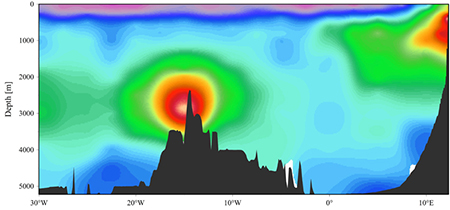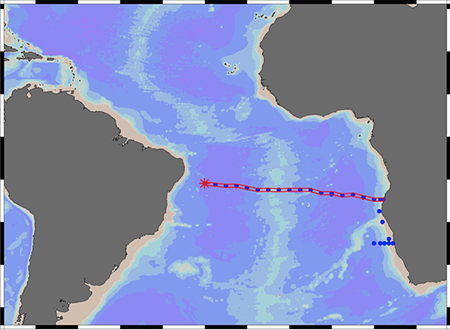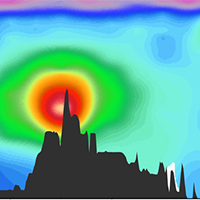The map shows the location of the ocean section where the plume was detected, highlighted in red (Abigail Noble, Woods Hole Oceanographic Institution)
Research by the University of Liverpool has found significant levels of iron and other micronutrients flowing from a hydrothermal vent in the South Atlantic ocean.
A team of scientists took samples from a range of depths as they travelled across the South Atlantic from Brazil to Namibia. Analysis of the samples revealed a distinct plume rich in iron and micronutrients above the mid-Atlantic ridge stretching for more than 1000km.
Hydrothermal iron supply
Previous studies of the region had found little presence of helium which was thought to be an indicator of hydrothermal iron supply and it had therefore been assumed the slow spreading ridges were not important iron sources.
The mid-Atlantic Ridge is a band of mountains and valleys running along the Atlantic Ocean floor from the Arctic to the Antarctic where several of the Earth’s major tectonic plates are slowly spreading apart.
 This figure plots ocean depth and sampling location, with elevated iron concentrations indicated by warm colors (red, orange, etc). The higher iron concentrations persist for more than 1,000 km, which suggests that hydrothermal vents serve as important iron sources. (Abigail Noble, Woods Hole Oceanographic Institution)
This figure plots ocean depth and sampling location, with elevated iron concentrations indicated by warm colors (red, orange, etc). The higher iron concentrations persist for more than 1,000 km, which suggests that hydrothermal vents serve as important iron sources. (Abigail Noble, Woods Hole Oceanographic Institution)
Hydrothermal vents, or fractures in the Earth’s crust, are found along the mid-Atlantic ridge, but these haven’t been extensively studied because slow-spreading ridges are thought to be less active than fast-spreading ridges of the Pacific.
Dr Alessandro Tagliabue, from the University’s School of Environmental Sciences, said: “From our knowledge of helium distributions, we did not expect these slow spreading ridges to be significant sources of iron.
“Our research findings challenge our current understanding of the importance of hydrothermal iron sources and implies we have underestimated their importance to the ocean system”
80 times higher
The study found that levels of iron in the plume were 80 times higher than in the fast spreading ridges of the South East Pacific. Iron is a critical element for ocean life which stimulates the growth of phytoplankton in many marine habitats and is therefore important in the ocean’s carbon cycle.
Dr Tagliabue added: “Further studies of the plume and other slow spreading ridges are necessary to discover the fuller implications of these findings and how hydrothermal systems affect the Ocean as a whole”
The research was carried out in partnership with the Woods Hole Oceanographic Institution and is published in Nature Geoscience.

